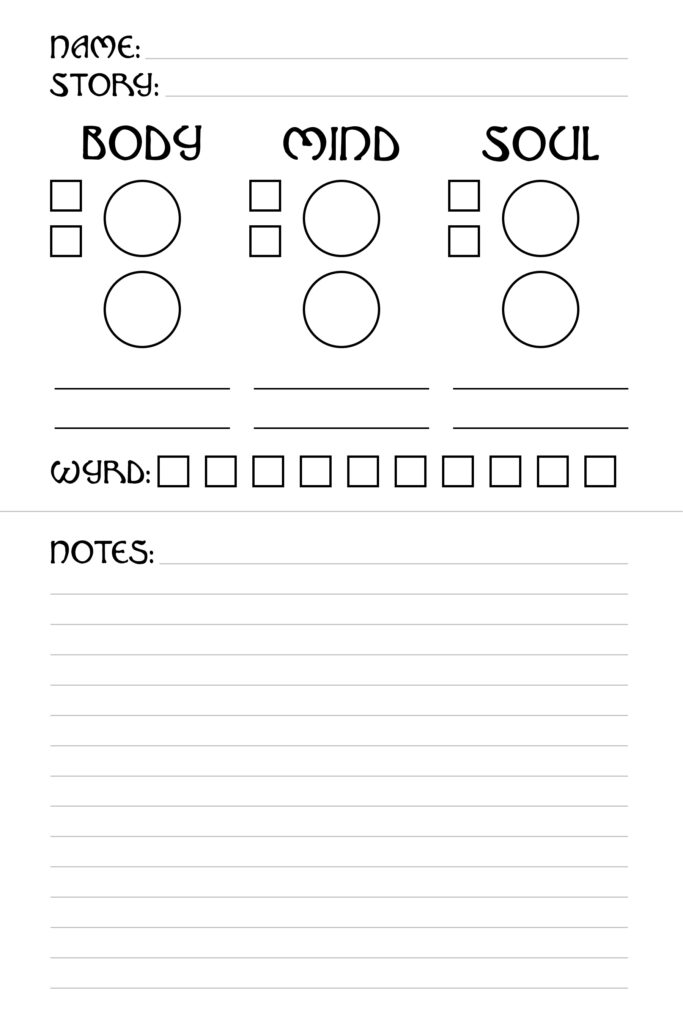Solemn Vale is a narrative-based RPG that sets out to emulate the eerie, slow-burn horror feel of British folk horror cinema from the 1970s. Think The Wicker Man, Penda’s Fen, The Stone Tape, A Warning to the Curious, Children of the Stones, and The Owl Service. (Naturally, the game also takes inspiration from more modern folk horror works such as Midsommar, The Witch, Ben Wheatley’s films, and yes, Hot Fuzz.)
Set in the fictional Devon town of Solemn Vale during that bleak decade, you play as outsiders who were drawn to this seemingly idyllic, middle-of-nowhere town for one reason or another. In a Systems Check session, we played the story “Footprints” from the free standalone rules — which functions as a sort of quickstart for the game — in which the players step into the role of a BBC production crew about to interview a lucky young resident of Solemn Vale. But what they found instead was an empty, shambolic house and the snare of the Wyrd…
The Wyrd Abacus
Solemn Vale‘s game system is officially called The Wyrd Abacus. In contrast to the evocatively-written setting, our table found the text explaining the rules to be bloated and difficult to grasp despite the actual rules themselves being relatively simple, even almost bare-bones compared to some of its peers in the horror RPG genre. The system boils down to this:
You have 3 attributes: Body, Mind, and Soul. You have a pool of points in each attribute. When you want to overcome a challenge, you spend a number of points from the relevant attribute and add that number to a d6 roll. If your total result meets or exceeds the Challenge Value set by the GM, you succeed at overcoming the challenge. Irrespective of success or failure, the number of points you chose to spend on that roll are deducted from the attribute’s pool. This mechanic is called a Challenge Roll and it’s the most frequent thing you will do in a session of Solemn Vale (though there are other types of rolls in the game too); it can be done either individually for each character or as a group, where all members of the group can contribute points towards the single d6 roll.
If you fail a Challenge Roll, worry not — you can draw from an independent pool of points called the Scene Wyrd Pool to add to the result until it meets the Challenge Value. It’s a finite resource attached to every scene in the story, a number of points equal to the number of players at the table plus one, refilled with each new scene. Whenever a character draws Wyrd Points from the Scene Wyrd Pool, they also add the points to their own Personal Wyrd Pool. The text suggests representing Wyrd with something physical and tactile, like a bowl of beads that players can take from (as we played online, I had to settle for a digital version of that using movable tokens).

Wyrd is the Anglo-Saxon concept of fate or personal destiny. The name implies that using Wyrd Points is akin to manipulating the forces of destiny in order to alter events to one’s advantage. However — to paraphrase a line from Netflix’s The Midnight Club — the more you pull on the rubber band of fate, the harder it snaps back at you.
At certain times during a scene, triggered by specific actions of player characters, the GM will call for a character or multiple to do a Wyrd Roll. They roll a number of d6s equal to the number of points they’ve accumulated in their Personal Wyrd Pool and take the highest result. A low result (1 or 2) may anchor the character back to mundane reality; for instance, they may discover that the unsettling noises coming from the walls were caused by nothing more than faulty pipes. But on a result of 6, the character attracts the unwanted attention of the supernatural or the malevolent — a poltergeist decides to play vicious pranks on that character, a masked cultist begins stalking them from the shadows, or worse.
Wyrd makes the game more interesting, enriches the dark atmosphere, and force-feeds the characters’ growing paranoia. This is where Solemn Vale excels — atmospheric, slow-creeping horror that builds towards a grippingly taut and tense climax. Either that rubber band will break, or you will. The players at my table agreed that the optimal way to play would be to lean into the role of the outsider: playing characters who are sceptical of the occult and/or turned off by the locals’ rural quirks, just so the Wyrd can mess with their heads even more.
As the story progresses, the challenges become harder and failure is increasingly punished; the characters will accrue damage to their Body, Mind, and Soul, docking off points from those attributes. If an attribute is reduced to 0 points due to damage, it is “scratched out”. If a character scratches out an attribute twice, they are dead or defeated — their body, mind, or soul having been broken. This can happen quicker than you’d expect; Solemn Vale is a game designed for short-term play.
This simple mechanic of gradually-decreasing attribute points is effective at creating tension and stress in the player, and that’s all Solemn Vale really needs. Unlike other RPGs, it does not use an independent meter to track a character’s health or sanity; since characters are entirely mundane people, their ability to overcome challenges is inseparably tied to their well-being. Unlike its horror RPG peers, it does not rely on intimidating statblocks or rollable tables of madness to craft a terrifying scenario. None of the threats in Solemn Vale have statblocks — they are all unconquerable forces of nature, as they should be.
Final Thoughts
Everyone in this Systems Check session gave glowing reviews for Solemn Vale, praising how the simple mechanics effectively reinforced the atmosphere of creeping dread, bewilderment, and tension as seen in folk horror movies. One player compared it favourably to Dread, the Jenga-based horror RPG.
From the GM side of the screen, I appreciated the tools Dirty Vortex gave us to create the right atmosphere and feel, particularly via the Stage Rules mechanic. Stage Rules are hidden rules tailored to the story or specific scenes within the story. (Taking an example from “Footprints”, in a scene set in the woods: “Failed Body and Mind challenges at this location inflict 1 Body damage in addition to all other consequences, as branches scratch, feet get caught in bracken and characters trigger animal traps.”) As one of my players pointed out, writing an original story for Solemn Vale is easy with this framework: choose a threat, create a three-act structure around that threat, and then come up with thematically-relevant Stage Rules for each scene.
If you’re looking for an alternative to Call of Cthulhu, Vampire: The Masquerade, or Vaesen, we highly recommend checking out Solemn Vale.

Get the standalone rules for The Wyrd Abacus here.
Pre-order Solemn Vale here.
Artworks featured are by Mark Kelly for Dirty Vortex.
Anyone is welcome to join a Systems Check session, and all sessions are beginner-friendly. Please join our Discord server to play and reach out to the GM when you sign up for a session.
You can also find us on these social platforms: